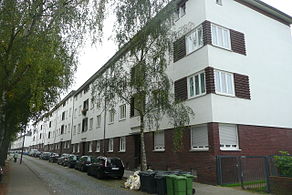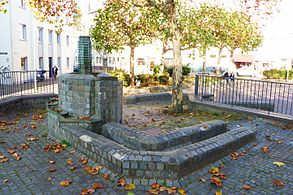East Quarter (Aachen)
The East Quarter is an urban area of Aachen , which includes large parts of the Rothe Erde district and some neighboring streets. The quarter has an area of around 240 hectares and is therefore almost as large as Aachen city center. It is largely located within the main traffic axes Adalbertsteinweg, Trierer Straße, Madrid and Berliner Ring as well as the federal motorway 544 between Europaplatz and the Rothe Erde exit. The district has historically emerged as a workers' district and garrison location and has been shaped by migration for many decades . The east quarter, like the neighboring and large industrial north quarter, is one of the social hot spots in Aachen and was therefore included in the Social City funding program from 1999 to 2010 .
Characteristic
The quarter is historically shaped by large industrial plants that were important during their active time. From 1845 to 1926, these were the steel company of the Aachener Hütten-Aktien-Verein Rothe Erde, on whose premises the tire manufacturer Engelbert / Uniroyal / Continental followed from 1929 . In addition, since 1949, the electronics group Philips Germany, with several divisions, has set up large areas in their immediate vicinity . This brought about the influx of numerous working-class families, initially mainly from Eastern European-speaking countries, for whom the industrial Talbot family in particular built several settlement buildings in the first decades of the 20th century, such as the apartment blocks on Josef-von-Görres-Straße. In addition, after the Second World War , the quarter experienced an influx of numerous urban families, as the war damage in the eastern quarter was far less than in the Aachen city center. The Yellow Barracks , which influenced life in the district from 1882 to 1944 as a military base, also served from 1946 to the 1950s and after appropriate renovation, among other things, as an emergency shelter for war returnees and then as a youth hostel and as a local police station.
Only when the "townspeople" withdrew into their newly built apartments from the 1950s and 1960s did the eastern quarter suffer from significant deficiencies in the urban, transport and cultural areas, due to an improvement in the infrastructure and the living environment was initially not considered necessary. As a result, the rent index inevitably remained low, which led to the influx of other less well-off citizens between the 1970s and 1990s. The quota of foreigners without German citizenship is 32.7% in Aachen-Ost, more than twice as high as in the city as a whole (14.2%). In addition, there are countless people with a migration background who, although they have German citizenship , feel like Turks, Iranians or Moroccans. The largest group of migrants in the district are Turks at 42.9% (compared to the city as a whole: 20.7%). Other large groups are Greeks and people from the former Yugoslavia.
Overall, more than 50% of the citizens in the quarter belong to Islam , significantly fewer belong to a Christian faith, of which around 7,000 are Catholics, the rest are Protestant and Orthodox Christians.
Projects as part of the Socially Integrative City program
After the infrastructure in the east quarter had deteriorated further towards the end of the last millennium and the local large-scale industry faced drastic economic changes, which led to a high unemployment rate, especially among young people in the quarter, and an above-average number of people living on social assistance, saw themselves In 1999 the city of Aachen was forced to apply for urban development funding for districts with special development needs from the Federal Ministry for the Environment, Nature Conservation, Building and Nuclear Safety and the state government of North Rhine-Westphalia , as it was unable to do so with its own financial resources. In accordance with the legal requirements, numerous local associations, institutions and companies, the gewoge , the responsible parishes of all denominations as well as citizens' initiatives and committed individual citizens participated in the planning of the necessary projects to improve living, working and living space in the east quarter. After the responsible bodies had approved the concept of the city of Aachen, over 400 projects were implemented between 1999 and 2010, including:
- Establishment of district offices for district conferences, steering and working groups; Reconstruction and extension of the community center of St. Corpus Christi
- Expansion and design of the most important thoroughfares in the quarter, including Hüttenstraße, Barbarastraße and Stolberger Straße, as well as redesign of Elsassplatz with street furniture and decoration, for example through approved graffiti
- Redesign of the station forecourt as well as renovation of the facades and reconstruction of the Rothe Erde station ; Construction of the Aachen Arkaden shopping mile including rooms for the health department of the city of Aachen on a disused part of the adjacent railway site
- Restoration and redevelopment of residential buildings from the Wilhelminian era including facade and greening programs; New construction of further settlements in the Panneschopp area (pan shed = roof tiles)
- Conversion of the former Rheinische Nadelfabrik AG into a house of identity and integration. It houses a boxing gym of the PTSV Aachen with the participation of the former German professional boxer in the light heavyweight division , Achim John as head coach. In addition, theater and assembly rooms as well as rooms for the office of the Aachen City Sports Association and the Aachen City Archives .
- New construction of the Yunus-Emre-Mosque of the Turkish-Islamic Union of the Institute for Religion (DITIB) in the Stolberger Straße
- The Kennedy Park , which was set up in 1965 on the site of the demolished Yellow Barracks, was upgraded as a central meeting point for cultures for “ multi-cultural festivals”, open-air events and as a sports and gaming facility
- Impressions East Quarter Aachen
refurbished housing developments on Josef-von-Görres-Strasse with the Europahochhaus in the background on Europaplatz
Benno Werth's fountain , Elsassplatz
In addition to the many individual projects, numerous permanent events have also been launched, some of which have continued outside the funding period and are now sponsored by local authorities, church institutions and social and charitable associations. These include:
- Neighborhood meetings, mothers' cafés, advice and guidance for young parents
- Violence prevention in schools, school yard redesign, establishment of movement kindergartens
- Theater and film projects, workshop of cultures and media library, district newspaper
- Aachen-Ost economic development , language courses, specialist training
Conclusion
The Socially Integrative City program has achieved a lot for the focal point Aachen-Ost: strengthened the local economy and supported structural change, improved the infrastructure and the living environment, ensured better opportunities for education and training and brought together the various ethnic groups . Nevertheless, the East Quarter offers space for criminal activities in the field of drug and violent crime, which have increased due to the increase in betting shops and gambling halls after the state monopoly on gambling was abolished in 2010. The overall problem was recognized by the city of Aachen and explained in a public consultation hour. At the same time, appropriate countermeasures were initiated in cooperation with the Aachen police authority.
Web links
- Documentation on urban renewal Aachen-Ost on the website of the city of Aachen
- History of the East Quarter , on the pages of St. Joseph and St. Corpus Christi
- Impressions from Aachen's east quarter
- Britta Rösener: Topography of the engagement in Aachen-Ost
Individual evidence
- ↑ City map aachen-Ost (pdf)
- ^ New living in the Ostviertel - documentation of the results of the architectural competition from November 2010 to August 2011 , information from the Gewoge on the website of the city of Aachen
- ^ District office Aachen-Ost: Balance after 11 years of program duration
- ↑ Martina Feldhaus: Put a stop to the betting offices , in Aachener Nachrichten of January 10, 2014
- ↑ Werner Breuer: Brennpunkt Ostviertel: Why multiculturalism is also exhausting , in Aachener Nachrichten of December 19, 2013
- ↑ Heiner Hautermans: Quiet has returned in the east quarter , in Aachener Nachrichten of January 29, 2014
Coordinates: 50 ° 46 ' N , 6 ° 7' E









